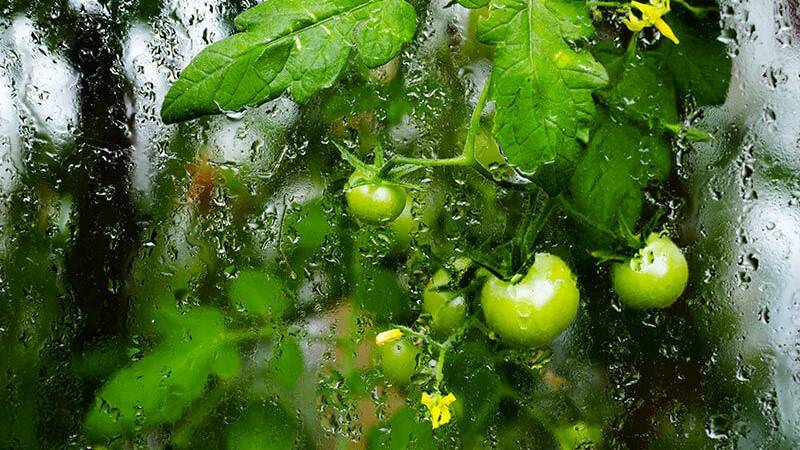How Does Humidity Influence Crop Quality?


Humidity can be the most difficult environmental factor to control in greenhouses. Even the most sophisticated environmental control equipment cannot perfectly control the humidity level in greenhouses. Humidity levels fluctuate with changes in air temperature and plants are constantly transpiring, which adds water vapor to the air. In the northern climatic areas, these challenges are multiplied by many factors, of which the drier, outdoor air that is too cold to perform air exchanges.
Humid air directly contributes to problems such as foliar and root diseases, slow drying of the growing medium, plant stress, loss of quality, loss of yields, etc. Therefore, more pesticides are needed for disease control and plants tend to have weak, stretched growth making the plant less desirable.
If the humidity is too low, plant growth is often compromised as crops take much longer to obtain the saleable size. Also, lower leaves often drop off, growth is hard, and overall quality is not very good. Whether the humidity is too high or too low, the loss of quality reduces the selling price of crops and increases production costs, both of which reduce profits.
Measuring Water Loss From the Plant
Humidity is the amount of water vapor in the air. The maximum amount of water vapor held by the air is dependent on the air temperature (warmer air holds more water than colder air) and, to a lesser extent, the air pressure. When we refer to air moisture, we normally express it in terms of relative humidity (RH).
This is because the absolute amount of water that can be held by air is constantly fluctuating with temperature. The relative humidity is expressed as the percent water vapor in the air in comparison to the total amount of water that could be held by the air if it were saturated. This RH is the most common way of expressing humidity levels, but it does not express plant water loss.
Vapor pressure deficit (VPD) is more accurate when determining water loss from the plant. VPD is simply the difference between the vapor pressure inside the leaf compared to the vapor pressure of the air. If the VPD is high, meaning that the vapor pressure inside the plant is higher than the outside air, then more water vapor escapes out through the stomates (pores in the bottom of leaves).
This process of water loss through the leaves is called "transpiration". If the VPD is low, the stomatal openings close and little water and fertilizer is taken up by the plant from the growing medium. VPD is important to know because it is used to schedule irrigations, to determine if air exchanges are needed and if air temperature needs to be increased to hold more moisture.
This VPD has been integrated into many greenhouse environmental control systems to manage humidity and for scheduling crop irrigation. Now, how does this apply to a crop?
Role of Humidity in Plant Growth
Plants are always adjusting their leaf stomatal openings based on the VPD and the humidity in the air. As seen above, high humidity is a problem because water usage by the plant is too slow and compromises quality, even though the stomates are constantly open. Likewise, if humidity is very low and subsequent transpiration is too high, the plant closes its stomatal openings to minimize water loss and wilting. Unfortunately, this also means photosynthesis is slowed and subsequently, so is plant growth.
As alluded to above, the two major functions of the plant that tie in closely with the humidity in the air and affect crop performance are transpiration and photosynthesis.
The Plant Transpiration Process
This is the process where plants absorb water through the roots and then give off water vapor through pores in their leaves. The drier or the hotter the air temperature, the faster the transpiration rate from the plant. However, the moisture deficit and transpiration rate are not directly related. This means that in very dry air, the increased rate of transpiration can only go so high in the plant and then it begins to wilt. For example, if the air is extremely dry, but the growing medium has enough water, the plant may wilt and, unless the humidity increases, the plant could die.
On the other hand, if the air is very humid the plant does not take up much water from the growing medium, which also means there is little uptake of fertilizer elements. This is a problem for some elements, particularly calcium, as inadequate uptake can lead to nutrient deficiencies.
Also, low water usage from the growing medium often correlates with climbing growing medium pH, which makes micronutrients such as iron unavailable to the plant. Typically, these problems are seen in the winter and early spring, when air temperatures in the greenhouse are low and transpiration is inadequate, or during the hot, humid summer months.
The Photosynthesis Process
This is the process of fixing carbon dioxide and water in the plant leaves to produce sugars that are used for energy and growth. When the temperature is high and humidity is normal, more stomates will open, letting in carbon dioxide for active photosynthesis. If the air is excessively dry and the plant is wilting, the stomatal openings close, thereby reducing photosynthetic activity and ultimately plant growth. The quality of the crop is dependent on the conditions that promote optimal photosynthesis and humidity plays a role in this process.
Plant Responses to Humidity
| Humidity Too Low | Humidity Too High |
| Wilting | Soft growth |
| Stunted plants | Increased foliar disease |
| Smaller leaf size | Nutrient deficiencies |
| Dry tip burn | Increased root disease |
| Leaf curl | Oedema |
| Increased infestation of spider mites | Edge burn (guttation) |
How to Reduce Humidity in the Greenhouse
It’s important to maintain a certain level of humidity in the greenhouse, but not to the point where it reaches the dew point. If the temperature in the greenhouse is at or below the dew point, the air cannot hold its moisture and starts to condense on the greenhouse, covering glazing and leaf surfaces. Water on leaves greatly increases disease problems and minimizes water uptake by the plant, increasing nutritional problems.
Sometimes it is difficult to keep the temperature above the dew point, because the air in the greenhouse is very humid, especially during winter months when air exchanges are limited. It is also a challenge as the greenhouse glazing is often cold due to frigid outside air so the moisture in the warm, humid internal air will condense on the inside of the glazing (see pictures 1 and 2).
Dripping becomes a major concern, even when the RH is adequate, as it causes uneven crop drying and increases diseases. The use of air flow devices and heating the air greatly helps, but RH can still be high enough to form condensation on cold surfaces.
An Infrared radiant heating system may help reduce condensation since it raises the temperature of hard surfaces, such as the plant and growing media surfaces, but not the air so there is less temperature variation between the inside and outside air. Keeping the air temperature more uniform throughout the greenhouse by using fans (see picture 3) and thermal screens, avoiding sudden temperature fluctuations, and adjusting irrigation practices based on the greenhouse environment and weather are all good methods to manage humidity and reduce condensation in the greenhouse.



How to Add Humidity in the Greenhouse
Humidity can be added, especially in propagation houses or when the air is too hot and dry, but it must be done without causing water to puddle on the floor or condense on the leaves or other surfaces in the greenhouse. This requires evaporative devices such as misters, fog units or sprinklers, which add water vapor to the air to reduce water loss through the leaves of unrooted cuttings or plants that are under extreme heat and low humidity conditions.
Evaporative devices accomplish three things:
- They cool air
- They add water vapor
- They reduce the vapor pressure deficit (VPD)
Keep in mind that increasing the humidity reduces the frequency requirement for irrigation. This has to be taken into account when watering a crop in the greenhouse.
Using a growing medium that has high water retention without causing asphyxiation is beneficial when the growing medium dries out too fast due to low humidity. Premier Tech offers products like PRO-MIX® HPCC AGTIV® REACH™ with chunk coir, which reduces watering frequency as it holds the water while maintaining good porosity and drainage.
The good news is that for most growers that have issues with high humidity, it can be corrected at a relatively low cost without having to acquire equipment to alleviate high humidity levels in greenhouses. However, if the humidity in the greenhouse is too low, using a good fogging system or evaporative devices that procure more humidity is mandatory, especially in propagation houses or the southern areas where drought and high temperatures prevail.
In both cases, good environmental control equipment in critical areas in the greenhouse is required for making decisions on corrective measures.
References:
- BC Ministry of Agriculture, Fisheries and Food. 1994. "Understanding Humidity Control in Greenhouses Floriculture" Fact Sheet file no 400-5.
- Scott Shelton. 2005. "Sweating High Humidity" Greenhouse Product News https://gpnmag.com/article/sweating-high-humidity/